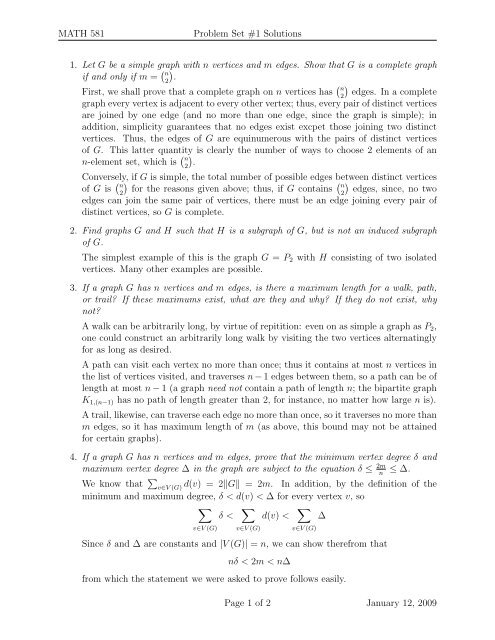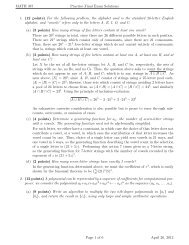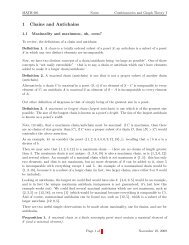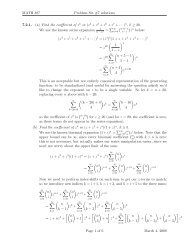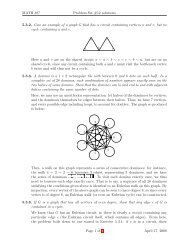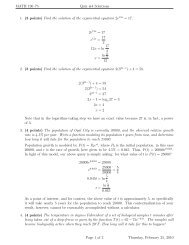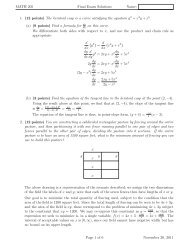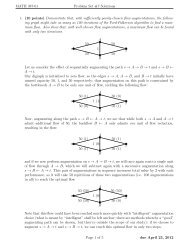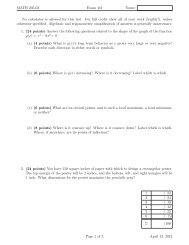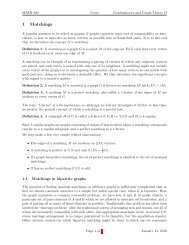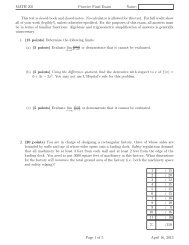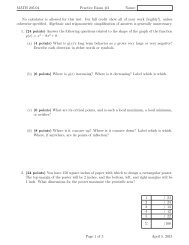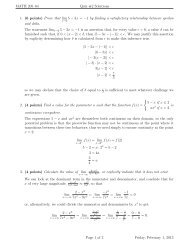MATH 581 Problem Set #1 Solutions 1. Let G be a simple graph with ...
MATH 581 Problem Set #1 Solutions 1. Let G be a simple graph with ...
MATH 581 Problem Set #1 Solutions 1. Let G be a simple graph with ...
Create successful ePaper yourself
Turn your PDF publications into a flip-book with our unique Google optimized e-Paper software.
<strong>MATH</strong> <strong>581</strong><strong>Problem</strong> <strong>Set</strong> <strong>#1</strong> <strong>Solutions</strong><strong>1.</strong> <strong>Let</strong> G <strong>be</strong> a <strong>simple</strong> <strong>graph</strong> <strong>with</strong> n vertices and m edges. Show that G is a complete <strong>graph</strong>if and only if m = ( n2).First, we shall prove that a complete <strong>graph</strong> on n vertices has ( n2)edges. In a complete<strong>graph</strong> every vertex is adjacent to every other vertex; thus, every pair of distinct verticesare joined by one edge (and no more than one edge, since the <strong>graph</strong> is <strong>simple</strong>); inaddition, simplicity guarantees that no edges exist excpet those joining two distinctvertices. Thus, the edges of G are equinumerous <strong>with</strong> the pairs of distinct verticesof G. This latter quantity is clearly the num<strong>be</strong>r of ways to choose 2 elements of ann-element set, which is ( n2).Conversely, if G is <strong>simple</strong>, the total num<strong>be</strong>r of possible edges <strong>be</strong>tween distinct verticesof G is ( n2)for the reasons given above; thus, if G contains( n2)edges, since, no twoedges can join the same pair of vertices, there must <strong>be</strong> an edge joining every pair ofdistinct vertices, so G is complete.2. Find <strong>graph</strong>s G and H such that H is a sub<strong>graph</strong> of G, but is not an induced sub<strong>graph</strong>of G.The <strong>simple</strong>st example of this is the <strong>graph</strong> G = P 2 <strong>with</strong> H consisting of two isolatedvertices. Many other examples are possible.3. If a <strong>graph</strong> G has n vertices and m edges, is there a maximum length for a walk, path,or trail? If these maximums exist, what are they and why? If they do not exist, whynot?A walk can <strong>be</strong> arbitrarily long, by virtue of repitition: even on as <strong>simple</strong> a <strong>graph</strong> as P 2 ,one could construct an arbitrarily long walk by visiting the two vertices alternatinglyfor as long as desired.A path can visit each vertex no more than once; thus it contains at most n vertices inthe list of vertices visited, and traverses n − 1 edges <strong>be</strong>tween them, so a path can <strong>be</strong> oflength at most n − 1 (a <strong>graph</strong> need not contain a path of length n; the bipartite <strong>graph</strong>K 1,(n−1) has no path of length greater than 2, for instance, no matter how large n is).A trail, likewise, can traverse each edge no more than once, so it traverses no more thanm edges, so it has maximum length of m (as above, this bound may not <strong>be</strong> attainedfor certain <strong>graph</strong>s).4. If a <strong>graph</strong> G has n vertices and m edges, prove that the minimum vertex degree δ andmaximum vertex degree ∆ in the <strong>graph</strong> are subject to the equation δ ≤ 2m n ≤ ∆.We know that ∑ v∈V (G)d(v) = 2‖G‖ = 2m. In addition, by the definition of theminimum and maximum degree, δ < d(v) < ∆ for every vertex v, so∑δ
<strong>MATH</strong> <strong>581</strong><strong>Problem</strong> <strong>Set</strong> <strong>#1</strong> <strong>Solutions</strong>5. Either give an example of a 3-regular <strong>graph</strong> on 7 vertices, or prove it cannot exist.Suppose such a <strong>graph</strong> G exists. We know that ∑ v∈V (G)d(v) = 2‖G‖. If a <strong>graph</strong> G is3-regular, than each d(v) is 3, so ∑ v∈V (G) d(v) = ∑ v∈V (G)3 = 3|V (G)| = 3 · 7 = 2<strong>1.</strong>Thus ‖G‖ = 21 2, a patent absurdityṖage2 of 2 January 12, 2009


